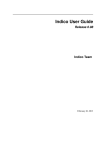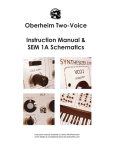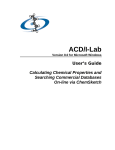Download njit-etd2000-069 - New Jersey Institute of Technology
Transcript
Copyright Warning & Restrictions The copyright law of the United States (Title 17, United States Code) governs the making of photocopies or other reproductions of copyrighted material. Under certain conditions specified in the law, libraries and archives are authorized to furnish a photocopy or other reproduction. One of these specified conditions is that the photocopy or reproduction is not to be “used for any purpose other than private study, scholarship, or research.” If a, user makes a request for, or later uses, a photocopy or reproduction for purposes in excess of “fair use” that user may be liable for copyright infringement, This institution reserves the right to refuse to accept a copying order if, in its judgment, fulfillment of the order would involve violation of copyright law. Please Note: The author retains the copyright while the New Jersey Institute of Technology reserves the right to distribute this thesis or dissertation Printing note: If you do not wish to print this page, then select “Pages from: first page # to: last page #” on the print dialog screen The Van Houten library has removed some of the personal information and all signatures from the approval page and biographical sketches of theses and dissertations in order to protect the identity of NJIT graduates and faculty. ABSTRACT AUTOMATIC CATEGORIZATION OF ABTRACTS THROUGH BAYESIAN NETWORKS by William Ramirez This thesis presents a method for assigning abstracts of Artificial Intelligence papers to their area of the field. The technique is implemented by the use of a Bayesian network where relevant keywords extracted from the abstract being categorized, are entered as evidence and inferencing is made to determine potential subject areas. The structure of the Bayesian network represents the causal relationship between Artificial Intelligence keywords and subject areas. Keyword components of the network are selected from precategorized abstracts. The work reported here is part of a larger project to automatically assign papers to reviewers for Artificial Intelligence conferences. The process of assigning papers to reviewers begins by using the inference system reported here to derive Artificial Intelligence subject areas for such papers. Based on those subjects, another module can select reviewers according to their specialization and limited by conflicts of interest. AUTOMATIC CATEGORIZATION OF ABSTRACTS THROUGH BAYESIAN NETWORKS by William Ramirez A Master's Thesis Submitted to the Faculty of New Jersey Institute of Technology In Partial Fulfillment of the Requirements for the Degree of Master of Science in Computer Science Department of Computer and Information Science January 2000 APPROVAL PAGE AUTOMATIC CATEGORIZATION OF ABSTRACTS THROUGH BAYESIAN NETWORKS William Ramirez Dr. Richard Scherl, Thesis Advisor Professor of Computer and Information Science, NJIT Date Dr. James Geller, Committee Member. Professor of Computer and Information Science, NJIT Date Dr. Yehoshua Perl, Committee Member. Professor of Computer and Information Science, NJIT Date BIOGRAPHICAL SKETCH Author : William Ramirez Degree : Master of Science in Computer Science Date: January 2000 Undergraduate and Graduate Education: • Master of Science in Computer Science, New Jersey Institute of Technology, Newark, NJ, 2000 • Bachelor of Science in Systems Engineering, Antioquia University, Medellin, Colombia, 1996 Major: Computer Science To my beloved family for all their support ACKNOWLEDGMENT I would like to express my sincere gratitude to Dr. Richard Scher', who was my Thesis Adviser and the main source of information by providing personal books and the software that make this thesis a reality, and Dr. James Geller, who was co-directing the Reviewer Selection Project and the connection point source allowing me to link my work to the rest of the project. I would also like to give special mention to a team member which whom I had some discussions and brought brilliant ideas to this thesis, Fredrik Ledin. vi TABLEOFCNS Chapter Page 1 INTRODUCTION . 1 2 BAYESIAN NETWORKS 8 2.1. Type of Connections 11 2.1.1. Serial Connections 11 2.1.2. Diverging Connection 11 2.1.3. Converging Connection 12 2.2. D-Separation 12 2.3. Basic Axioms 2.4. Conditional Probabilities 13 13 14 2.5. Likelihood 2.6. Probability Calculus for Variables 14 2.7. Conditional Independence 16 2.8. The Chain Rule 17 2.9. Probability Updating in Joint Probability Tables 18 23 3 PROJECT DESCRIPTION 3.1. Knowledge Base 24 26 3.1.1. Functional Specification 27 3.1.2. Process Description 27 3.1.3. Design 28 3.2. Inference Engine System vii TABLE OF CONTENTS (Continued) Page Chapter 3.2.1. Functional Specification 34 3.2.2. Process Description 35 3.2.3. Design 41 4 CONCLUSIONS 46 APENDIX A USER MANUAL 47 APENDIX B SOURCE CODE 52 APENDIX C REVIEWER SELECTION SMALL EXAMPLE DATA 82 REFERENCES 88 viii LIST OF TABLES Page Table 1 Conditional probabilities 15 15 2 Joint Probabilities P(A,B) 3 Conditional probability for Light-on 20 4 Conditional probability P(dog-out|bowel-problem,family-out) 20 5 Conditional probability for Hear-bark 20 6 Weight values for the "superset" keyword node 30 7 Probability values for the keyword node "superset" 30 ix LIST OF FIGURES Page Figure 1 Functional Model 6 2 A Causal Diagram 10 3 Serial Connection 11 4 Diverging Connection 12 5 Converging Connection 12 6 Propagation of evidence (outdoor light is on) 21 7 Propagation of evidence. (Dog is outside the house). 22 8 Flow Chart Diagram — Rule Constructor 26 9 Algorithm for the Rule Constructor program 27 10 A causal diagram for Reviewer-Selection. 31 11 Import Subjects subroutine 35 12 An example of a Categorization network 36 13 Propagation of evidence — Small example 14 Flow chart Diagram Inference Engine System 37 38 15 Main Subroutine : Assign probabilities to areas 39 16 Main subroutine : Import keywords 40 17 Main subroutine : Assign probabilities to keywords 41 18 Ontology File 82 19 Weight Table 82 CHAPTER 1 INTRODUCTION In 1997, Professor James Geller, wrote a challenge paper for the International Joint Conference on Artificial Intelligence(IJCAI). The challenge problem was to automatically assign reviewers to papers for this conference. The same technology could be used for other conferences as well. The paper "Challenge: How IJCAI 1999 can prove the value of AI by using AI" based its motivation of automatic assignment of reviewers in the way the current program for assigning papers to reviewers worked. The program used in 1997 for such a conference was basically a very limited program in many different manners. Created by Ramesh Patil at USC/ISI, this program was not even intended for this conference, but for the National Conference on Artificial Intelligence(AAAI), so extra processing was required to accommodate the program to the particular requirements of IJCAI. The general algorithm of this program was, that an author submitted a paper with a list of content areas that the paper could be categorized, this list could not be extended since it actually represented all the content areas included in Patil's program, after this information was input into the system, the program assigns papers to reviewers according to the content areas of expertise of them. 2 From the previous sentence, one can infer two basic problems : The partial analysis of the document from the author; the program was not intelligent enough to deduce subject areas, and the limitation of the program on accepting new content areas. In other words, the author describes this issue as the contradiction of the use of a non-artificial intelligence program for the Artificial Intelligence Community. The proposal of Prof. Geller with regards to what could be improved, can be summarized in the following way : Authors will supply a list of Content areas from any topic of Artificial Intelligence, and an intelligent program based on these contents and by analysis of the body of the document will determine potential content areas and at the same time will find reviewers for those papers. In those cases where program results were not reliable, a data entry process will be required. Adding to this statement, this thesis aims to eliminate the need for the authors to submit content areas, since the system will generate them automatically. Then, a general framework was developed in order for, the different teams that wanted to participate on this challenge, to have the same conditions. The framework consisted of electronic submission of paper for IJCAI 1997, so that all teams would have them available online. Authors were asked to submit a list of five to ten individuals that they would consider good reviewers for their papers. The process of selection of reviewers is conditioned as follows : Reviewers can not have the same affiliation as the author, author can not be presented as a suggested reviewer, author's doctoral advisor can not be a reviewer, people with whom the author has recently written cannot be potential reviewers, no reviewer can have more than thirty papers; papers must have a reviewer. 3 The World Wide Web was proposed as a source of information to fulfill the reviewers conditions. A general processing example of how to solve the problem will give a better understanding on how this issue can be faced : abstract can be submitted online or in batch mode and a data entry system will process them. The knowledge based system contains information such as the content areas, potential reviewers and references. A keyword extractor program will draw out significant keywords from the abstracts and a categorizer program will analyze those keywords and make inferences about the potential areas of the paper. The last stage involves the assignment of reviewers to the potential areas of the paper. Reviewers are chosen according to their specialization and by matching certain restriction rules such as : no reviewers can be selected with the same affiliation as the author, the author of the paper can not be selected as a reviewer, the author's advisor is not accepted as a reviewer, a reviewer can not be assigned fifty papers, nor can a paper be reviewed by 50 persons, reviewers that the author has recently written a paper with are not allowed to be reviewers for such a paper. A reviewer selection module supports these constraints and returns as the output, appropriate reviewers based on these limitations. The system then, send data about reviewers previously entered in the system and potential content areas to a checking reviewer module which will verify reviewer's assignment conditions and determine appropriate reviewers for such a paper. Should there be no information pertinent to the reviewer, a web-crawler module would interface with World Wide Web Search Engines to try to find information about reviewers. 4 In answer to the challenge, a group of NJIT students started the development of what is called the "REVIEWER SELECTION" project. The general structure of the project consists of four different modules that communicate to each other : Data Entry module, composed of a web interface and a batch process, Data Analysis module, conformed by a keyword extractor program and keyword — abstract counter program that will generate valuable information to the rest of the system, the Inference module composed of an statistical program for keywords-areas and the Categorizer program that will infer potential content areas, and the last module is the Reviewer selection module which will determine the best reviewers according to the conditions described before in this chapter. The functional schema of the system is presented in . In this figure all the different system components that interact, are displayed : • Web Interface: It will be used as the online input of abstracts. So authors of papers for IJCAI, can submit papers by using this interface. Not only abstracts are entered, but also, the content areas given by the author and a list of five to ten potential reviewers chosen by the writer as well. • Batch Processing: This batch processing will allow the processing of more than one abstract. These abstracts are submitted to the system by using a flat file. This module is required in order to gather paper from old conferences. • Keyword Extractor : It will select significant words from the abstract in order to determine potential content areas. These words are called keywords and the program by using grammar rules will identify and then draw out verbs and nouns. Common nouns and verbs from the English glossary will be eliminated. 5 • Data Analyzer : This program generates statistical information that will be used for the inference engine. It takes as input the keywords extracted from the Keyword Extractor and try to find the number of occurrences of each keyword in the abstract being processed. As a result the Data analyzer will save information in the knowledge base about : keyword, paper, content area, and number of times the keyword occurs. • Statistics Program : This process, based in the information gathered by the data analyzer, tries to make up some probabilistic values that would represent relationship between content areas and keywords. The result of this will be a table showing a probabilistic value representing the relationship between keyword and content area. • Inference Engine or Categorizer : By the use of Bayesian networks, content of abstract can be analyzed and determined AI subject areas where it can be classified. Once the category of the paper is determined, reviewers may be assigned as they are in the Database as experts in that area. This is what this work is based on. • Reviewer Selection Program : This program tries to find reviewers according to the content areas of a document. It is also responsible for resolving conflicts of interest about a particular reviewer (Author and reviewer belong to the same affiliation, Reviewer is also author of the paper, Reviewer has recently written a different document with this author, etc.). As a result, this will return a list of n reviewers, where n is a predefined value, with no conflicts of interest at all. This thesis describe my work on the problem of automatically assigning categories to papers by using a Bayesian networks. The document is organized into : a theoretical framework about Bayesian networks, a discussion of how Bayesian networks can be used to perform the categorization problem, the implementation and Conclusions. The Figure 1 Functional Model Ch 7 implementation of the network, was possible by the use of an API (Application Program Interface) called Hugin, which , supports all the different components of Bayesian Networks. CHAPTER 2 BAYESIAN NETWORKS Also known as belief networks, knowledge maps, probabilistic causal maps, It is a method of reasoning using probabilities. Judea Pearl gave its actual name in 1988, but the ideas are a product of many hands. Application of this theory has not only been accepted in Computer Science topics, but in others such as medicine (medical diagnosis), marketing and customer support, and robotics. Companies such as Microsoft and Hewlett Packard have applied these methodologies for developing outstanding intelligent software programs. An expert system, is a system that analyzes the state of the world and based on its interpretation, decides on an action. Then the system expects some results from the action, which it will make come true or not, the results are used as a feedback to the same system. For instance, a physician examines a patient, and gets a record of symptoms, then she/he will conclude in a diagnosis and prescription of medicaments to cure the disease. After the prescription is applied the physician gets feedback from the patient visits and then she/he reformulates his/her prescription. The first computer-based expert system was constructed in 1960. These systems were based in computer models of an expert such as : doctor, engineer, and mechanic. The constructs for these systems were production rules. A production rule is of the form. If condition then fact or if condition then action. 8 9 These systems, then were called rule based systems, consisting of a knowledge base' and an inference system 2 . The knowledge base is a set of production rules and the inference system combines rules and observations to come up with conclusion about the state of the world. The only drawback of these models was when conditions were not totally assured, then results were not 100% accurate. Some modifications were proposed about this matter and one of then was to use production rules adding a certain probability value of belief. These rules are of the form : If condition with certainty x then fact with certainty f(x). A Causal or Bayesian Network, is a DAG (Direct Acyclic Graph) composed of nodes that represent random variables, and arcs that represent the relation of causality between nodes, these arcs are also called the independent assumptions of the network. When there is an arc or link from Node A to Node B, it is said that A is the parent of B, and in the same way B is a child of A. In Figure 2, there is an example of a small network representing the case when a person on his way home, wants to know whether his/her family is in. First of all, if the family is out, then the dog is taken to the yard and sometimes when the dog is at the yard, her bark can be heard. The family also turns on the light when they leave, but they also turn it on when they are awaiting a visit. The dog is also taken to the back yard when the dog has bowel problems. As you can see from the diagram, arcs represent relation of causality like in the case of "family out", then the "dog is out". This type of reasoning can be expressed in a more formal way as follows : The Event A causes with certainty x the event B. (causation statement) Knowledge base : facts, assumptions, beliefs, heuristics, and expertise, in this project we refer to the information stored in the database. 10 Figure 2 A Causal Diagram In the same way, given the fact that the dog is out, one would like to know if this is because the "family is out" or the dog has "bowel problems". In this case the two root nodes are dependent to each other. This is called conditional dependence and the fact can be expressed in a more formal way as follows : If we know that A has taken place, then B has taken place with certainty x.(reasoning statement). As described before, each node is represented by a variable, which represents events (propositions). In some cases these variables represent Boolean events, such as in the previous example where every node represents a Boolean event (i.e. The dog is out of the house or not). Each event value is called a state, so in the case of Boolean variables, there are two states, but variables can have more than one state. A variable, may, for example, be the color of a car (states blue, green, red, brown) or a disease (states : bronchitis, 2 Inference system: the process by which lines of reasoning are formed. 11 tuberculosis, lung cancer). At any time a variable is in one state, which it may be unknown. When a state is known in a certain point of time is called evidence. 2.1. Type of Connections 2.1.1. Serial Connections It is a cascaded influence between Nodes. From Figure 2, Bowel problems influences dog out, which at the same time, one can hear the dog barking. In a formal way this is expressed as given three nodes : A,B, and C. if A influences on B, which in turn influences on C, is a serial connection. Obviously, evidence on A will influence the certainty of B which then influences the certainty of C. If the state of the intermediate node is known , then the channel is blocked, and A and C, in this case become independent. A and C are said to be d-separated and B is called an instantiated variable. Figure 3 Serial Connection 2.1.2. Diverging Connection Influence can pass between all the children of A unless the state of A is known. Nodes are d-separated only and only if A is instantiated. 12 Figure 4 Diverging Connection 2.1.3. Converging Connection In this case, If nothing is known about A, then the parents become independent. In the example of figure 2, if the fact that the dog is out is uncertain, then nothing can be assumed about the state of whether the family is out or the dog has bowel problems. If any other kind of evidence, influences the certainty of A, then the parents become dependent . The evidence may be direct evidence on A, or it may be evidence from a child. This phenomenon is called conditional dependence. Figure 5 Converging Connection 2.2. D Separation - Two variables A and B in a causal network are d-separated if for all paths between A and B there is an intermediate variable V such that either : the connection is serial or diverging and the state of V is known or the connection is converging and neither V nor any of V's descendants have received evidence. 13 If A and B are not d-separated, they are called d-connected. The implication of these definition denote that if A and B are d-separated, changes on the certainty of A have no impact over the certainty of B, and vice versa. Before proceeding with the quantitative formulation of Bayesian networks, it is required to formulate the basic principles of this theory. This principles are based on classical probability calculus. 2.3. Basic Axioms The probability P(A) of an event A is a number in the unit interval [0,1]. Probabilities obey the following basic axioms. i. P(A) 1 if and only if A is certain. ii. If A and B are mutually exclusive, then 2.4. Conditional Probabilities A conditional probability statement is of the following kind : Given the event B, the probability of the event A is x. The notation for this statement is : P(A|B) = x. This notation is strictly read as If B is true, and everything else known is irrelevant for A, then 13(A) = x. The fundamental rule for probability calculus is the following: Where P(A,B) is the joint probability of the event A and B. Conditioning equation 1 to a context C, then we get the following formula : 14 By analogy, from equation 1 we have the fact P(B|A)P(A) P(AIB)P(B) = P(A,B), which yields to the well known Bayes' rule: Bayes' rule conditioned by a context C will read, 2.5. Likelihood Likelihood of B given A is P(A|B), and it is denoted by L(A|B). It measures how likely it is that B is the cause of an event A. So, imagine different scenarios for different values of B = B1B2...B n , then P(A|BI) calculates such a likelihood. If all Bis have the same prior probability, Bayes' rule yields where k is independent of i. 2.6. Probability Calculus for Variables As mentioned before, a causal network is composed of links and nodes, where each node represents a random variable which in a given time it is just in one state. This last sentence means the all states of a random variable are mutually exclusive and for each state, there is a probability associated to it. 15 X I , denotes the probability of A being in state al. Therefore, the probability of A being in state ai is denoted P(A = ay) and denoted P(al) if the variable is obvious from the context. If there is a variable B, which states are : b1...b m , then the conditional probability P(AIB) is an n x m table that consists of a probability for each configuration (al, bj), See table below. Table I. Conditional probabilities B1 B2 B3 Al 0.4 0.3 0.6 A2 0.6 0.7 0.4 One can notice that the sum for each column is equal to one. From the conditional probability equation on equation 1, P(ai|bj)P(bj) = P(ai,bj) = P(ai,bj) If we use the same table above to calculate P(A,B) with a vector Bj = (0.3, 0.5, 0.2) and multiply each column, the result would be P(ai, bj). See table below Table 2 Joint Probabilities P(A,B) B1 B2 B3 Al 0.12 0.15 0.12 A2 0.18 0.35 0.08 16 The sum of all cells gives the value of one. From a table P(A,B) the probability distribution P(A) can be calculated. Let al be a state of A. There are exactly m different events for which A is in state al, namely the mutually exclusive events (ai, Then the conclusion is . This calculation is called marginalization, and it says that variable B is marginalized out of P(A,B) (resulting in P(A)). The notation is From the previous example, we get the following values for P(A) = (0.39, 0.61). 2.7. Conditional Independence Two variables are considered d-separated or independent when the following condition holds : The variables A and C are independent given the variable B if This definition may look asymmetric ; however if equation 6 holds, then by the conditioned rule (Equation 4), we get : As a summary of all the information presented, a Bayesian network consists of the following : • A set of variables and a set of directed edges between variables • Each variable has a finite set of mutually exclusive states. 17 • The variables together with the directed edges form a directed acyclic graph (DAG) • To each variable A with parents B 1 , ³ . there is attached a conditional probability If a node A has no parent, then this node does not have conditional probabilities, but instead, it has initial values, which are called unconditional probabilities. 2.8. The Chain Rule Let P(U) be the joint probabilities of all variables in a Bayesian network. P(U) = P(A 1 ,...,An ) where U is the universe of variables: U = (A1,...,A n ). From this joint probability table, it is possible to calculate the individual probabilities P(A1 ) as well as P(Ai|e), where e corresponds to an evidence. However the computation of P(A i ) grows exponential in the way the number of variables increase, and therefore computation takes longer. There should be a more compact way of calculating P(U) without the exponential time factor and it is by the use of the conditional probabilities from the Bayesian network. Theorem: (The chain rule) Let BN be a Bayesian network over Then the joint probability distribution P(U) is the product of all conditional probabilities specified in BN: Where pa(Ai) is the parent set of Ai. 3 A DAG is characterized because there is no directed path A1-->... -An such that A1=An 18 2.9. Probability Updating in Joint Probability Tables Let A be a variable with n states, A finding on A is an n-dimensional table of zeros and ones. Semantically, a finding is a statement that certain states of A are impossible. Now, let U be a universe of variables, and assume that we have easy access to P(U), the universal joint probability table. Then, P(B) for any variable B in U is easy to calculate: Suppose we wish to enter the above finding. Then P(U, e) is the table resulting from P(U) by giving all entries with A not in state i or j the value zero and leaving the other entries unchanged. Again, P(e) is the sum of all entries in P(U,e) and Note that P(U,e) is the product of P(U) and the finding e. If e consists of several findings (f1,...,fm) each finding can be entered separately, and P(U,e) is the product of P(U) and the findings fi . This can be expressed in a more formal way as follows : Theorem : Let U be a universe of variables and let e = fl, Where fm}. Then 19 Following, there is an example of a Bayesian network and how calculation are done. The Bayesian network in Figure 2, would be used and the problem statement is the following: Let us suppose that Dr. Mason wants to know if by the time he comes back home at night, his family is at home before trying the doors. He has some clues that may help him guess in advance : Often when his wife leaves the house, she turns on an outdoor light. However, she sometimes turns on this light if she is expecting a guest. Also, there is a dog, that when nobody is home, it is put in the backyard. The same is true if the dog has bowel troubles. Finally, if the dog is in the backyard, he will probably hear her barking, but sometimes, he can get confused by other dogs barking. After the statement is present, the next step is to model the network. As mentioned before this example is represented by the model in Figure 2. From the model we find out that we have two unconditional probabilities : family-out and bowel-problems, and the rest of nodes require conditional probabilities such as : P(light-on | family-out), P(dog-ut'family,bwepros)P(ha-bkIdgout.Frechnwavto states with the values or true-false. So in the case of family out is true, we give a value of 0.30, and in false case we give a probability value of 0.7. This means that 70% of the cases, the family is at home. For bowel problems, a probability of 0.20 and 0.8 is predefined for each case. For the conditional probabilities, as a matter of example, let us take the case of P(light-on | family-out). 20 This means the probability that the light is on, given that the family is out. In these case, the value is 0.79. The rest of values and the tables for the rest of conditional probabilities are shown below : Table 3 Conditional probability for Light-on Table 4 Conditional probability P(dog-out|bowel-problemfamily-out) True False, Bowelproblem False True 0.02 0.06 0.005 0.98 0.94 0.995 Family-out False True False 0.95 0.05 True I Table 5 Conditional probability for Hear-bark i 21 From this table, one can deduce that the number of pr9~tabilities to compute for each node is proportional to the number of:nodes and the number of states of each node. So the formula can be expressed as : # of states for ~ode i = I1#of states of Node j, for all parents nodes of node i, including it itself. Suppose that when Mr. Mason is very close home, he finds out that the outdoor light is on, so we entered this value as evidence and propagate the results. The results are shown in the following graphic Figure 6 Propagation of evidence (outdoor light is on) From the original unconditional probability values for family-out (0.7, 0.3), they have now become 0.1456 for the fact that the family is in, and 0.8544 for the fact that the family is out. What this shows that the evidence that the light is on, increments the probability that Mr. Mason's family went out. Now, since Mr. Mason suspects that his family is away, he walks trough the alley to reach the backyard to confirm his suspicions. Finally he found the dog outside, and therefore he is pretty sure that his family is not in. (See figure below). 22 Figure 7 Propagation of evidence. (Dog is outside the house). As the graphic suggests, the probability of family-out, has increased from 0.8544 to 0.9531 since the last evidence, which confirm the certainty that the family ': is out. Also from the bowel-problem node, the value of the probability of the dog, not having bowel problem is 0.7684, this is because the belief that the dog is out is because the family is out since the outdoor light is on. CHAPTER 3 PROJECT DESCRIPTION This project consists in the implementation of a Bayesian network that will be used to determine content areas of Artificial Intelligence documents. This network is composed of an ontology of all Artificial Intelligence areas and significant keywords that are indicative of a paper belonging to particular areas. Since a Bayesian network represents a causal relationship between its components, the causal relationship between the different Artificial Intelligence topics is represented upside down with respect to that of the Ontology; influence is explained as pointing from specific to generic subject. Additionally, there is a causal relationship between AI content areas and keywords. At the end of this chapter I will use a small example of the network to explain how the network is constructed and show the results after inferencing. The ontology is read from an ASCII file where the classification is represented in terms of indentation, AI is displayed at the first line and flushed completely to the left. The next levels in the classification are indented with respect to the previous ones. As we know, Bayesian networks are initialized with probability values, so this information is extracted from a knowledge base composed of one Oracle table, called weight. The weight table is used to determine the degree of association between a keyword and an Al subject; a value called weight, is computed based on statistical formulas. According to a threshold weight value, keywords are imported into the Bayesian network, and these values are used to generate the conditional probabilities required for the network. After keywords have been incorporated into the Bayesian 23 24 network, then the network can be used for inferencing. The process starts by inputting the abstract or paper from a front-end interface such as a web page or a batch file, relevant keywords are extracted from the document and then passed into the Bayesian network to be entered as evidence. Keyword nodes that match those found in the document are set to one, and the keywords not present are set to zero. Then, this information is propagated throughout the network. Another program will check for content areas with high probability values. These high probability values mean a strong relationship between the content area and the evidence just entered. The content areas selected are then displayed as the content areas of the abstract or document. 3.1. Knowledge Base The idea of this program is to give valuable data to the inferencing system in order to have good predictions. Valuable data, in the case of REVIEWER-SELECTION means a method or formula to determine the association that exists between a keyword and a particular content area.. Traditional probabilistic methods such as frequency of occurrence can not work in this case, since they would only calculate how many times a keyword will occur in a document or in other words, the frequency of occurrence of words inside Al documents. After certain period of investigation We based our approach on that used by Salton4 for a similar problem : the problem of indexing terms to document content for easy retrieval, in how to identify what is relevant and what it is not relevant. He, then figured out, that in written text, grammatical function words such as "and", "of', "or", and "but" exhibited approximately an equal frequency of occurrence in 25 different documents of different contents. So he also analyzed the case of nonfunction words, and he found out that there were extreme variations in frequency and that in some way those variations were related to the document content. He concluded then, that the frequency of occurrence of non-function words may be used to indicate term importance for content representation. Then he proposed the following algorithm to extract valuable term from documents : I. Eliminate common function words from the document texts. 2. Compute the frequency for all remaining terms 3. Choose a threshold value T , to select those terms with a value greater or equal than T and reject the rest. There was a problem with this algorithm, using frequency of occurrence, was not a very selective way to determine association between terms and content areas. This is true because when calculating frequency for a keyword that occurs in more than one content area, there would not be any difference to that one of a keyword that occurs in only one document. So there should be a way to punish those terms or keyword that occurred in more than one content and in some way to increase the value of those terms that appeared in documents of a specific content. Salton, found similarities in the concept weight and his observations, so he developed the following formula : Let Wij, be called weight or importance of a term or keyword Tj in a document Di, and is defined as the keyword frequency multiplied by the inverse document frequency. 4 The name of the book is : Automatic Text Processing , the author is : Gerard Salton. 26 For the purpose of this thesis, we have adapted this formula in the following way : Wu = will determine the weight or in other words, the closeness of association between a particular keyword i and a particular area j. = Indicator ratio. = # of papers of area j in which keyword i occurs Total number of papers of area j The values for IRIS will be supplied from the data analyzer which outputs to an , Oracle database table: the id of the document, the keyword occurred in the document, the content area the document belongs to, and the number of times the keyword occurs within the document. 3.1.1. Functional Specification Following is the flowchart diagram of the statistical program. Figure 8 Flow Chart Diagram — Rule Constructor The program receives as input : PaperId which is the identifier that uniquely distinguish each document, Content Area, the area the document belongs to, Keyword , is the keyword found in the document and extracted as a relevant keyword from the keyword extractor, Ntimes, number of times the keyword happens in the document. Then 27 the Rule Constructor generates the weight for each combination of keyword-are and outputs the result into the Weight table. 3.1.2. Process Description This module generates a weight value which represents the degree of association between keywords are Artificial Intelligence content areas. The weight value is computed by using Equation 8. B egin Query = SELECT DISTINCT AREA,KE YWO RD FROM STATIC For each record in Query do Extract area and keyw or d in areal keyw or d1 Compute IN as number of paper where area = areal and keyword= keyword1 divided by total numb er of papers of area= areal Compute second term of the formula by summing all IN that have as a. k eywor d = keyword1 . Assign this value into sumAllIRij. Weighti= IRij * logo otal number of areas, sumAllIRij) ht, keywor di, and areal in Weight table Store Weig Read next record from Query End for End pr ocess. Figure 9 Algorithm for the Rule Constructor program 3.1.3. Design Program was implemented using Java 1.2 and information was extracted from Oracle tables corresponding to the database model for this project. In Java, a special module called JDBC was used, this module allowed the connectivity between Java and Oracle. This program is not part of the interactive module, it works in batch mode and it is run every time the information in the static table is changed. The source code of this program can be found in Appendix B of this document. 28 3.2. Inference Engine System The inference engine system has to deal with the creation of a Bayesian network in order to automatically derive content areas from keywords contained in a paper. The structure of the network is composed of content areas supplied from Artificial Intelligence and keywords extracted from the rule constructor. Artificial intelligent subjects are classified in a way of a DAG (Directed Acyclic Graph). In this type of network, specific nodes are not associated to one general subject; a specific subject may be related to more than one subject area. So at the highest level of the hierarchy, there are the most specific classified subject areas and at the lowest level, there is the AI subject with all the immediate higherlevel subject areas connected to it. Information about the content areas of AI, is stored in a text-file, in which, for each line, there is a subject category and there is an indentation that represents the relationship between the subject in the previous one and the current one. With regards to keywords, not all keywords in the weight table are imported in the Bayesian network, only those keywords with a weight greater than a threshold value will be used. As a summary of the representation of the Bayesian network, areas will be in the top level configured in a way of a DAG and at the bottom level , keywords are located. The way keywords are connected to areas depends on the weight values, so there will be some cases where a keyword is connected to just one area , or other cases where a keyword is connected to more than one. A tentative diagram is shown in Figure 10. Once areas are extracted from the text file and keywords are imported based on the threshold value from the static oracle table, the next point would be to assign probabilities to these nodes. All these nodes are Boolean nodes, what they express in the 29 case of an area, is the probability of certainty of a content area based in a more specific area, and in the case of a keyword node is the probability of certainty of a keyword happening in a document of that type. The conditional probabilities, such as in the case of the keyword "superset" in Figure 10, may express 'Probability of the keyword 'superset' happening, given that this paper is classified in 'coalitions' but not in 'AI architectures' ". Those nodes with no parents are initialized inversely proportional to the number of orphans. In the case of areas, according to the structure, an area is usually influenced by more than one node (multiparent). Therefore probability tables are usually big, and for reasons of simplicity I assumed a probability value of 1 if any of the parents (influencing nodes) occurs in the document. When computing the case when none of the parents occur in the document , I assume a probability of 0 and 1 for the case of "yes" and "no" respectively. Keywords have a different way of assigning probabilities with respect to areas since these can have more than one parent. The only information provided for computing probabilities is the weight value, which is not enough, since in the case of one parent, it is required four different values (each value for each combination parent-node). The assumption taken from here is : add all the weights of all parents of the keyword node, for every combination probability the value would be the multiplication of the weight values of the nodes involved in the combination over the total sum of weight to the power of the number of parents. For instance, let us use the keyword "superset" from Figure 10 and assume we have the following weight values : 30 Table 6 Weight values for the "superset" keyword node. Area Weight AI architectures 4.50 Coalitions 3.08 Total sum = 4.50 + 3.08 = 7.58 Since we have three nodes involved and each node has two states, we have 2 3 = 8 different probability values to assign to the keyword node "superset". Here are the probability values for this particular case : Table 7 Probability values for the keyword node "superset" Figure 10 A causal diagram for Reviewer-Selection. U.) 32 In the scenario where AI-architecture = No, Coalition = Yes and Superset = Yes, it is noticed that the only node affecting is Coalition, so then, the probability value is the division of its weight over the total sum of all weights. From the first column, also notice that probability of keyword "superset" happening, given that the document is not classified as AI-architecture, neither Coalition is 0. This value is because it is assumed that a keyword can not appear in a document of any other subject than the one it is related to in the Bayesian network. After all probability values have been assigned, the network can be used for inference. A new abstract is inputted into the web interface, and then this interface calls the keyword extractor to extract relevant words from the document. These keywords are then entered into the Bayesian network as evidence. Those keywords that are not present in the Bayesian network are taken out of the evaluation. After setting evidence on the different nodes, by using the Universal Joint probability, the evidence is propagated and the new probability values are drawn out. A program will scan probability values throughout the area nodes and those nodes with significant probability values are then displayed as potential subject areas for such document. As a purpose of understanding, following, I will use a small example to demonstrate how the project works, starting from the Ontology ASCII file until the potential subject area that fits to the document is deduced after inference. Appendix C presents a small portion of the ASCII file as well as the different probability tables of every node in the network. Figure 12 shows a small Categorization network, composed of the area nodes : AI, Distributed AI, Decision trees, real-time systems, search, planning, causality, description 33 logic, theorem proving and cognitive modeling, and keywords membership, real-time, pathways, simplex and epsilon. Probability values for subject areas are set to 1 for all the cases when any of its parents happens as explained before. Keyword are assigned probability values depending on the weight values extracted from the Weight table of those subject areas that influence it, therefore, in the case of epsilon, this node has two subject areas as parents : cognitive modeling and theorem proving. The weight values extracted from this table are 3.34 for cognitive modeling and 4.78 for theorem proving. Therefore as explained before, the probability of epsilon happening (being yes) given that the document is classified under cognitive modeling but not in theorem proving is equal Prob(epsilon = yes I cognitive modeling = yes & theorem proving = no) = 3.34 / (3.34 + 4.78) = 0.41 Apendix C contains all the input data to the Bayesian network : the ontology file, keywords extracted from the weight table and the probability tables of every node. After probability tables are ready with the values assigned for each combination case, the network is ready for inference. Let us suppose the system is tested with a document that contains the words "simplex", "real-time" and the rest of words are not present in the document. Once keywords are extracted from the document, they are entered as evidence in the system. In this case, then, the two keywords are entered as evidence, which means its certainty is set to 100 percent in the case of yes. For those keyword nodes whose keyword, do not occur in the documents, are set to zero percent in the case of True. Then propagation of these values is done throughout the network. The results of the propagation are shown in Figure 13. Analysis is started from the top level of the Bayesian network based on the fact that the more selection of specific subject will lead to more 34 accurate results. A threshold probabilistic value is assumed for purposes of selecting the potential subject areas that the document may fit. Therefore a value of 55 is chosen for this examples, so subjects nodes under that value are discarded, otherwise they are inserted in the list of potential nodes. By looking at the "yes" field values of the top level, the highest value is achieved by real-time systems with a value of 51 below the threshold. In this case since none of the nodes reach or overpasses the threshold, then selection is moved to the next level of specific subject areas. In the second level, the highest value is obtained by decision trees which is 56; this value is over the based value, therefore this subject is picked as a potential classification subject for the given document. Results in lower levels are discarded since they represent redundant information like in the case of decision trees and distributed AI where the later is a generalization of the earlier(i.e. the fact that the document fits in distributed AI is redundant, given that the document is already fitted under a subcategory of distributed Al). As a result of the inference, Decision Trees is displayed as the subject where the example document can be classified. 3.2.1. Functional Specification The flowchart that represents the different programs that make up the Inference system is given in page 38. In the storage symbol, in the middle of the graphic, you can see the name "Hugin Knowledge base file", this is the file type used by Hugin to store networks. The text file that contains the list of subject areas, represents the classification by means of indentation , so the more indented the file, the more specific the classification is. The "Graphical representation" process was not included in the functional 35 specification because of lack of relevance, this routine is more important for the presentation of results. 3.2.2. Process Description Import Areas This routine imports Al subject area names from a text file. The classification of these subject areas is represented in the text file as a matter of indentation. If a subject appears more indented that the previous one, it means that the subject is classified under this previous. The subject areas are then incorporated into the Bayesian network. A detailed specification of the algorithm is displayed in Figure 11. Main subroutine Begin Create new domain d. Operl the text file with all the content areas. Read the first line o f text file While not end of the text file Do. Extract area name from text line. Create new no de in the B.N with the area name just extracted. Call recursive subroutine Imp ort Subjects. End while. Save domain d End subroutine. Import Subjects subroutine. Begin Read next line from text file. If it is not the end of fil e then If line is indented with regards to previous line then Extract subject name from text line. Create new node in BN with name just extracted from text file. Link this new no de as child of node read from previous line. Make recursive call to Imp ort Subj ects subroutine. End if End if End subroutine. Figure 11 Import Subjects subroutine Figure 12 An example of a Categorization network Figure 13 Propagation of evidence - Small example. Figure 14 Flow chart Diagram Inference Engine System 39 Assign Probability to Areas This subroutine assigns probability values to the imported areas into the Hugin file. The number of probabilities to compute, depends in whether a node in the Bayesian network has links or not. In the case of a root node, default values must be assigned, like in the case of the Al node, the probability values were 0.5 for each case. The other case presented in this network is a node connected to one parent in which the values are computed based in the number of children of the parent node. Figure Figure 15 displays the corresponding algorithm. Main subroutine Begin Open domain d For each node in the domain d Do If no de is a root node then Prot' ability values are 0.5 for both cases Else Find number o f siblings for this node For probability value equal "yes'', assign the value 1/ (number of siblings). In the case of "no", assign the value of 1 — 1/(number of siblings) End if End for. Save domain d with new changes. End sub routine. Figure 15 Main Subroutine : Assign probabilities to areas Import Keywords Keywords are extracted from the Reviewer Selection database, based on a threshold value. The information stored in the database is keyword, area, and weight. The threshold value is compared against the weight to extract those pairs keyword-area with a weight bigger than threshold. Once keyword-area are drawn out, the keyword is inserted as a node into the Bayesian network and is linked to the area node corresponding to area 40 extracted from the database. The weight value is saved on the keyword node with the purpose of computing probabilities for the keyword later on. The algorithm is explained in the next figure. Main subroutine Begin Get threshold value from command line Get username and password from command line to connect to oracle database Open domain d Select 1 = "SELECT KEYWORD, AREA, WEIGHT FROM WEIGHT WHERE WEIGHT > :threshold". Connect to oracle database with username and password Execute select_1 For each recor d extracted from s el ect_1 Do Draw out keyword, area, and weight from record Look for area inside domain d If node found with same area name then Look for keyword inside domain d If no de found with same keyword name then Link area node as parent o f keyword node Else Create new no de and give it keyword name in d. Link area node as parent of this new keyword node End if Insert weight and parent name as attribute inside keyword no de End if End for. Save domain with new changes. Close connection to oracle database. End subroutine. Figure 16 Main subroutine : Import keywords Assign Probability to Keywords After keywords are imported into Hugin, probability values need to be assigned in order to process the network. As different to the case of Al content areas, keywords can have more than one parent, which implies more probabilities to compute. Depending on the number of parents the number of probability values is equal to 21' + 1 , where n is the 41 number of parents. Probabilities are then computed based on the AI content areas involved in the condition. After assigning probabilities, the Bayesian network is ready for inference. The algorithm is explained in next figure. Main. subroutine Begin Open domain d For each keywor d node inside domain d Do Find the number of parents of keyword node If number o f p arents = 1 then Probability values will be 0.3 for the case"no", and 0.7 for "yes" Else From. the keyword node, compute the sum of the weight of all parents connected to this node Numb er of probabilities to calculate = 2 to the power of numb er a fp arents For i = 1 to the number of probabilities to calculate Do Convert i into binary format. From the binary format, determine which parents are involved in such a combination. For each parent involved in combination multiply the corresponding weight value and store it into num. At the same time multiply total sum as many times as parents involved in the combination and store into den. Probability for "yes" = num den Probability for "no" = 1 — num I den. End 63r End if End for Save domain d End subroutine. Figure 17 Main subroutine : Assign probabilities to keywords 3.2.3. Design The inference engine system is basically written in C language, and developed for the Unix Operating system. This system was built with the help of an Artificial Intelligent software tool called Hugin, which is specially design for the manipulation of Bayesian Networks (A demo version can be downloaded from their website http://www.hugin.dk). This software comes with two applications, one is the runtime program which is used for 42 the graphical manipulation of networks, and the other is an API 5 library developed in C which provides the same functionality as the runtime program. Following is a brief description of all the different functions from the API version 4.0, used in the development of this project. In order to use the Hugin API, you need to include the library <hugin.h> in your C program and make sure that you have the environment variable $HUGINHOME set in your .cshrc file. To compile the program also be advised of the following command line : %homer> cc —I$HUGINHOME/include —c myprogram.c Hugin also handles the following datatypes : • h_number_t : single precision floating point. • h doublet : double precision floating point. • h_triangulationmethod: defines the possible triangulation methods used during compilation. • h error t : defines the various error codes returned when errors occur during execution of API functions. • h status t : common return value of some API functions. If value is zero, the function succeeded; if the value is nonzero, the function failed and the value will be the error code. • h_stringt : used as a character string data type. • h_domaint t : domain data type. A domain is the name given from Hugin to the whole network • 5 h_node_t : Node data type. Node of a BN network Application Program Interface 43 Here it is a brief description of most of the API functions used in our project : h_domain_t h_new_domain(void) : creates a new empty domain. If creation fails, NULL is returned. h_node_t h_domain_new_node(h_domain_t domain, h_node_category t category, h_node_kind_t kind) : Create a new node of the indicated category and kind within domain. h_status_t h node_delete(h_node t node) : Remove node (and all links involving node) from the domain to which node belongs. h_statust h_node_add_parent(hnode_t child, h_node t parent) : Add node parent as a new parent of node child. h_node_t * h_node_get_parents(h node _t node) : Return a NULL-terminated list comprising the parent nodes of node. h table t h_node_get table(h_node t) : Return the probability table associated with node. If the node is a chance node, the table is the conditional probability table for node given its parents. h_node t h_domain_getfirst_node(h_domaint domain) : Return the first node of the domain. The first node is based on the most recent created node. This is with the purpose of traversing. h_node_t h_node_get_next(h_node_t node) : return the node that follows node according to the date of creation. 44 h_status_t h_node_set_attribute(hnodet node, h_string_t key, h_string_t value): Insert a new attribute into node. This was used in the thesis with the purpose of storing the weight values of the parents of node. h_string_t h_node_get_attribute(h_node t node, h string_t key): Return the value associated with key in the attribute list for the node. h_status_t h_domain_save(h_domaint domain, h_string_t filename, h_endian_t format) : Save the domain as a HUGIN kb to a file named filename. h_domain_t h_load_domain(h_string_t filename) : Load a domain from the HUGIN KB file named filename. h_ node_ t * h table_get_nodes(h_table_t table) : Retrieve the NULL-terminated list of nodes assoicated with the table. If an error is detected, NULL is returned. h_number_t *h_table_get_data(h table t table): Retrieve a pointer to the array of table holding the actual discrete data (denoted by x[i]). This array is a one-dimensional representation of the multi-dimensional array. It is possible to modify the contents of the table from this pointer. size t h table_get_size(h_table_t table): Return the size of the table. If an error is detected, (size t) —1 is returned. h_status t h_node_set_subtype(h_node t node, h_node_subtype t subtype): Set the subtype of the node to subtype. h_node_subtype t can be any of the followings : h_subtype_boolean or h_subtype_label. By default is set to h_subtype_label, write_net(h _domaint domain, FILE * net_file) : produce a status _t h_domain specification of the Hugin kb file in text format using a native language called NET. 45 In order to import the keyword to the Hugin Bayesian network was necessary to use Pro*C, a C language for Oracle since information was stored in an Oracle Table. The rest of the programs were written in C including the HUGIN library. CHAPTER 4 CONCLUSIONS The planned objectives from the beginning of the project were accomplished to the fullest. Even this particular case of categorization of documents for Artificial Intelligence, could be extended for the classification of documents in other disciplines by means of supplying the respective ontology of the discipline and the correct assignment of probability values to the association between keywords and the elements of the ontology. The success of the thesis is reflected in the following attained achievements: • The construction of the Bayesian network through the extraction of the Artificial Intelligence ontology from an ASCII file and the importation of keywords from an Oracle database based on a threshold value. There is no limitation from the network with regards to the number of components (whether it is a keyword or content area). • The creation and implementation of a statistical formula that determines the degree of association between a keyword and a content area. This formula allows deriving the probability values required to feed the Bayesian network. • Portable and network independent algorithms for the assignment of probability values. The routines utilized for the assignment of probability values can be used in any type of network configuration, also they interface with varied types of software languages such as Java, Pro*C and C language. • The graphical representation of the Categorization network. This was achieved by the use of the Hugin API and can be displayed using the Hugin runtime program. 46 APENDIX A USER MANUAL The expert system is composed of six program files written in Java, Pro*C and C. There is also an oracle table called "weight" used as the knowledge base for the system. The Operating system over which the programs were created was Unix System V version 4.0. These programs are not user interactive, they work in batch mode and parameters are given from the operating system command line. The program files are located in the server : logic.njit.edu and the path is : /home/challeng/william. In order to have access to the files, you need to telnet logic; if you are on campus, just telnet to logic, outside the University campus, telnet to logic.njit.edu . The program files that use the Hugin API, do not run under the logic account because license was only purchased for one server which is : homer.njit.edu . So compilation and execution of such programs must be made from any homer account. Program file : RuleConstructor.java Description : This programs builds the knowledge base for the inference system. It generates and inserts weight values in the weight table. Currently, the program works for the shared oracle account challeng. Language used : Java 1.2 How to compile : from the command line type the following line : Logic% javac RuleConstructor After compilation, a file RuleConstructor.java is generated. 47 48 How to run : from the command line type the following line : Logic% Java RuleConstructor Table description : Name : Weight Fields : AREA VARCHAR2(35), KEYWORD VARCHAR2(25),WEIGHT NUMBER(8,4) Program file : import_a.c Description : This program imports the AI subject areas from a text file. Language used : C language. How to compile : This program only compiles in Homer, since Hugin API is installed there. There is a file that contains all the compile instructions for this program : compimp. This file generates the executable called import_a. So in the command line type the following : Homer% compimp How to run : There are two arguments for this program, one is the text file with the AI subject areas, which for this case is called INPUTA.DAT. Notice that the file must be typed uppercase because Unix is case sensitive. The other argument is the output Hugin file where areas will be stored. Homer%import_a INPUTA.DAT bayesnet Program file : builprob.c Description : Assign probabilities to subject areas. This program is dependent of the network structure. So it only works with the current structure. Language used : C language. 49 How to compile : There is a compile file to execute, called compbuild. It creates the executable : buildp. This program as well as the previous one can only be compiled and executed in Homer. This is the line to compile it : Horner% compbuild How to run : It requires only one argument which is the name of the Hugin file. The Hugin file should contain all the subject areas at this point. Here it is the command line : Homer%buildp bayesnet Program file : impkey.pc Description : It extracts keywords from the weight oracle table to the Hugin file, according to a threshold value given as a parameter to the program. It also links keywords to Al subject areas based on the information stored in the table. Language used : Pro*c precompiler How to compile : Since this program uses Hugin API library functions, it can only be compiled in Homer. There is a makefile file with all the compilation instructions for this program. The file is called test.mk. From the command line type the following : Homer%make —f test.mk EXE=impkey OBJS=impkey.o After compiled, an executable file called "impkey" is created. How to am : The parameters are : 1. Threshold value : starting value for importing keywords into Hugin file. 2. Oracle username : Oracle name 3. Oracle Password : Oracle password 4. Hugin file : Hugin file which should include the AI subject areas. 50 A typical command line should look like this : Homer%impkey 4.50 challeng@logic chal101 bayesnet Program file : assignkp.c Description : Assign probability values to keywords after they have been imported from the weight table Language used : C language How to compile : There is a compile file called compass. This compilation only works in Homer. Homer%compass How to run There is only one parameter which is the Hugin file. This file at this point should include the keywords imported from the oracle table. The command line is : Homer% assignkp bayesnet Program file : drawnet.c Description : This programs generates the graphical coordinates in order for the categorization network to be displayed in the Hugin Runtime module. Language used : C language How to compile : There is a compile file called compdraw. As well as most of the programs, it only compiles and runs in Homer. The command line to compile is : Homer% compdraw How to run : Drawnet requires three parameters : the name of the Hugin file which should be complete at this point, the width of the node given in pixels, and the height given also in pixels. The command line should look similar to this : 51 Homer%drawnet bayesnet 50 30 In order to see the graphic representation of the categorization network, you need to run Hugin runtime which is also installed in Homer. It is required to have an account in Homer to run the Hugin runtime. The procedure for running Hugin runtime is : 1. Logon into a Unix machine that has Xwindows or OpenWindows 2. Open a shell command Window inside Xwindows or OpenWindows 3. Type the following command from the local host : xhost +homer.njit.edu 4. Telnet to homer.njit.edu with username and password 5. After being logged on, make sure you have set the environment variable HUGINHOME or that you include the following path in your command line : /usr/local/Hugin/bin. 6. In the command line type xhugin if you have the HUGINHOME variable set, otherwise type the full path : /usr/local/Hugin/bin/xhugin 7. Open the categorization file from the directory you have it stored. APENDIX B SOURCE CODE RuleConstructor.j ava 52 53 54 55 56 57 58 59 60 61 62 63 64 65 66 67 68 69 70 71 72 73 74 75 76 77 78 79 80 81 APENDIX REVIEWER SELECTION SMALL EXAMPLE DATA Here is a detailed specification of input information to this problem : first, you will see the input ASCII file corresponding to the different AI subjects, then the conditional probabilities for all the nodes that compound the example of Figure 12. AI distributed AI decision trees real-time systems search planning search causality description logic planning search causality theorem proving causality cognitive modeling Figure 18 Ontology File AREA KEYWORD real-time systems distributed AI decision trees description logic planning causality theorem proving cognitive modeling real-time real-time simplex pathways membership membership epsilon epsilon WEIGHT 41 6.89 5:0 4.2 3.69 4.59 4.30 4.49 Figure 19 Weight Table 82 83 Conditional Probability Table 1 real-time systems. State Value Yes 0.25 No 0.75 Conditional Probability Table 2 search. State Value Yes 0.25 No 0.75 Conditional Probability Table 3 causality. State Value Yes 0.25 No 0.75 Conditional Probability Table 4 Cognitive modeling. State Value Yes 0.25 No 0.75 84 Conditional Probability Table 5 decision trees. search False I No Real-time sys. False|No True|Yes FalseINo 1 0 TruelYes 0 False|No Conditional Probability Table 6 planning causality False I No True | Yes search FalselNo False|No 1 0 True|Yes 0 1 Conditional Probability Table 7 theorem proving I False|No TruelYes 0 0 85 Conditional Probability Table 8 Distributed Al planning False I No True I Yes Decision trees False|No False|No TruelYes False|No True|Yes True|Yes 0 1 1 1 Conditional Probability Table 9 Description logic Theor. Prov. planning False|No False | No VFalse|No True | Yes A True|Yes 1 False|No True|Yes 0 0 1 True(Yes Conditional Probability Table 10 AI Dist. AI True I Yes False I No Desc. log FalselNo TruelYes FalselNo True(Yes 0 1 1 1 False|No Tru-e|Yes 86 Conditional Probability Table 11 simplex Decis. Trees d FalselNo TruelYes False|No 0.6 0.45 True|Yes 0.4 0.55 Conditional Probability Table 12 pathways Desc. Logic False|No False|No I 0.7 True|Yes I 0.3 TruelYes 0.25 I 0.75 Conditional Probability Table 13 real-time False | No FalsetNo True|Yes FalselNo True|Yes 0.41 0.37 0.59 0.63 0.75 I 0.35 0.25 I 0.65 1 87 Conditional Probability Table 14 membership planning False|No True|Yes False!No True|Yes False|No 0.9 0.2 0.35 0.26 True|Yes Conditional Probability Table 15 epsilon Cog. Mod. I True | Yes False | No True|Yes FalsefNo Theo. proving False|No TruelYes False|No 0.85 0.42 I 0.59 I 0.51 0.15 0.58 I 0.41 I 0.49 True|Yes I REFERENCES 1. E. Charniak, "Bayesian Networks without Tears", AI MAGAZINE, American Association for Artificial Intelligence (AAAI)., Menlo Park, CA, 1991, pp. 50-64. 2. J. Geller, "Challenge: How IJCAI 1999 can prove the value of AI by using Al", Proc. Of the Fifteenths International Joint Conference on Artificial Intelligence (IJCAI 1997), Morgan Kaufmann Publishers, Nagoya, Japan, August 1997, pp. 55-58. 3. F. Jensen, An Introduction to Bayesian Networks, Springer-Verlag, New York, NY, 1996. 4. G. Salton, Automatic Text Processing, The Transformation, Analysis, and Retrieval of Information by Computer, Addison-Wesley Publishing Co., Reading, MA, 1988, pp. 279-280. 5. G. Weiderhold. "Model-free optimization.", Proc. DARPA Software Technology Conference, Meridien Corp. Arlington, VA, 1992, pp. 83-96. 88




















































































































